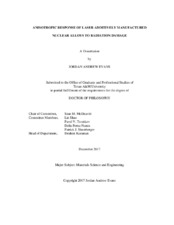| dc.description.abstract | The impact of radiation-induced effects on the properties of alloys fabricated using additive manufacturing (AM) was evaluated through the implementation of ion beam irradiation testing followed by electron backscatter diffraction (EBSD), scanning electron microscopy (SEM) with energy dispersive spectroscopy (EDS), nanoindentation, scanning probe microscopy (SPM), and transmission electron microscopy (TEM). Inconel 600 (I600) and 316L stainless steel (316L) rods were fabricated by Quad City Manufacturing Laboratory in collaboration with Lockheed Martin for this study. The rods were produced in three distinct orientations (vertical, horizontal, and 45°) using laser additive manufacturing (LAM). Conventionally manufactured I600 and 316L rods were purchased from Metal Samples, Inc. to enable comparative studies. The I600 and 316L LAM specimens were heat treated to 900 °C and 650 °C in argon with no cold working, respectively. Similarly, the conventionally manufactured I600 and 316L control specimens were cold rolled and annealed at 980 °C and 1040 °C in argon with no cold working, respectively.
XRD of unirradiated specimens showed differences in peak ratios between build orientations, indicating anisotropic grain structures for samples fabricated by LAM. All LAM rods contained significantly fewer coincidence site lattice (CSL) boundaries and more residual strain compared to the controls before and after irradiation, regardless of build direction, as determined by EBSD. Material performance parameters such as resistance to radiation-enhanced embrittlement, corrosion, creep, intergranular stress corrosion cracking, and hydrogen-induced cracking were inferred from CSL theory, which suggests that all LAM rods are more susceptible to grain boundary-related failure mechanisms than their conventionally manufactured counterparts. All alloys built by LAM are strongly textured with parallel to the build direction before and after irradiation. Directionally dependent Taylor Factor distributions suggest that resistance to slip depends on build direction where, from highest to lowest resistance: horizontal > 45° > vertical.
All I600 samples experienced radiation-induced segregation which, according to SEM/EDS and SPM studies, resulted in the formation of chromium carbide precipitates on to the irradiated surfaces. Strong anisotropic mechanical behavior was observed in the LAM rods, as measured by nanoindentation and bulk tensile testing. The hardness of the unirradiated as-annealed specimens, from greatest to least, is: horizontal > 45° > vertical. The radiation-induced hardening of LAM specimens, from greatest to least, is: horizontal > 45° > vertical. The orientation dependence of radiation-induced segregation and hardening mechanisms is discussed.
The ultimate outcome of this work is a first-of-a-kind high-dose radiation damage study of alloys fabricated by LAM, revealing that the radiation-induced changes in material properties for these alloys is dependent upon build orientation. | en |


